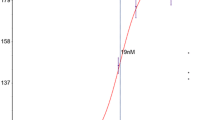Abstract
In most dose–response studies, repeated experiments are conducted to determine the EC50 value for a chemical, requiring averaging EC50 estimates from a series of experiments. Two statistical strategies, the mixed-effect modeling and the meta-analysis approach, can be applied to estimate average behavior of EC50 values over all experiments by considering the variabilities within and among experiments. We investigated these two strategies in two common cases of multiple dose–response experiments in (a) complete and explicit dose–response relationships are observed in all experiments and in (b) only in a subset of experiments. In case (a), the meta-analysis strategy is a simple and robust method to average EC50 estimates. In case (b), all experimental data sets can be first screened using the dose–response screening plot, which allows visualization and comparison of multiple dose–response experimental results. As long as more than three experiments provide information about complete dose–response relationships, the experiments that cover incomplete relationships can be excluded from the meta-analysis strategy of averaging EC50 estimates. If there are only two experiments containing complete dose–response information, the mixed-effects model approach is suggested. We subsequently provided a web application for non-statisticians to implement the proposed meta-analysis strategy of averaging EC50 estimates from multiple dose–response experiments.








Similar content being viewed by others
References
Clothier R, Gómez-Lechón M, Kinsner-Ovaskainen A et al (2013) Comparative analysis of eight cytotoxicity assays evaluated within the ACuteTox Project. Toxicol Vitro 27(4):1347–1356
Core TRD (2013) R: a language and environment for statistical computing. R Foundation for Statistical Computing, Vienna, Austria, 2012. ISBN: 3-900051-07-0
DerSimonian R, Laird N (1986) Meta-analysis in clinical trials. Control Clin Trials 7(3):177–188
Finney DJ (1976) Radioligand assay. Biometrics 32:721–740
Hartung J, Knapp G (2001a) On tests of the overall treatment effect in meta-analysis with normally distributed responses. Stat Med 20:1771–1782
Hartung J, Knapp G (2001b) A refined method for the meta-analysis of controlled clinical trials with binary outcome. Stat Med 20(24):3875–3889
Hedges LV, Olkin I (1985) Statistical methodology in meta-analysis. Academic Press, New York
Hunter JE, Schmidt FL (2004) Methods of meta-analysis: correcting error and bias in research findings. Sage, Thousand Oaks
Jiang X, Kopp-Schneider A (2014) Summarizing EC50 estimates from multiple dose–response experiments: a comparison of a meta-analysis strategy to a mixed-effects model approach. Biometric J 56:493–512
Lindstrom MJ, Bates DM (1990) Nonlinear mixed effects models for repeated measures data. Biometrics 46:673–687
Morris CN (1983) Parametric empirical Bayes inference: theory and applications. J Am Stat Assoc 78(381):47–55
Pinheiro JC, Bates DM (2000) Mixed effects models in S and S-PLUS. Springer, Berlin
Ritz C, Streibig JC (2005) Bioassay analysis using R. J Stat Softw 12(5):1–22
Sidik K, Jonkman JN (2005) Simple heterogeneity variance estimation for meta-analysis. J R Stat Soc Ser C Appl Stat 54(2):367–384
Viechtbauer W (2005) Bias and efficiency of meta-analytic variance estimators in the random-effects model. J Educ Behav Stat 30(3):261–293. doi:10.3102/10769986030003261
Viechtbauer W (2010) Conducting meta-analyses in R with the metafor package. J Stat Softw 36(3):1–48
Acknowledgments
We thank our colleagues Dr. Tim Holland-Letz, Dr. Manuela Hummel, and Ann Thüringer for providing valuable comments and proof reading. The work of Xiaoqi Jiang was supported by the European Union’s Seventh Framework Collaborative Large-Scale Integrating Project Predict-IV under Grant agreement No. 202222.
Author information
Authors and Affiliations
Corresponding author
Rights and permissions
About this article
Cite this article
Jiang, X., Kopp-Schneider, A. Statistical strategies for averaging EC50 from multiple dose–response experiments. Arch Toxicol 89, 2119–2127 (2015). https://doi.org/10.1007/s00204-014-1350-3
Received:
Accepted:
Published:
Issue Date:
DOI: https://doi.org/10.1007/s00204-014-1350-3




